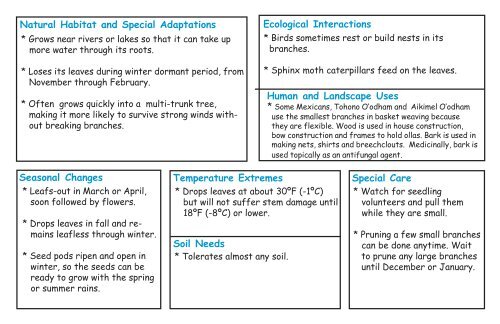Desert Willow - Arizona-Sonora Desert Museum
Desert Willow - Arizona-Sonora Desert Museum Desert Willow - Arizona-Sonora Desert Museum
Natural Habitat and Special Adaptations * Grows near rivers or lakes so that it can take up more water through its roots. * Loses its leaves during winter dormant period, from November through February. * Often grows quickly into a multi-trunk tree, making it more likely to survive strong winds without breaking branches. Ecological Interactions * Birds sometimes rest or build nests in its branches. * Sphinx moth caterpillars feed on the leaves. Human and Landscape Uses * Some Mexicans, Tohono O’odham and Aikimel O’odham use the smallest branches in basket weaving because they are flexible. Wood is used in house construction, bow construction and frames to hold ollas. Bark is used in making nets, shirts and breechclouts. Medicinally, bark is used topically as an antifungal agent. Seasonal Changes * Leafs-out in March or April, soon followed by flowers. * Drops leaves in fall and remains leafless through winter. * Seed pods ripen and open in winter, so the seeds can be ready to grow with the spring or summer rains. Temperature Extremes * Drops leaves at about 30ºF (-1ºC) but will not suffer stem damage until 18ºF (-8ºC) or lower. Soil Needs * Tolerates almost any soil. Special Care * Watch for seedling volunteers and pull them while they are small. * Pruning a few small branches can be done anytime. Wait to prune any large branches until December or January.
- Page 2 and 3: Desert Willow Type and Size Mimbre
Natural Habitat and Special Adaptations<br />
* Grows near rivers or lakes so that it can take up<br />
more water through its roots.<br />
* Loses its leaves during winter dormant period, from<br />
November through February.<br />
* Often grows quickly into a multi-trunk tree,<br />
making it more likely to survive strong winds without<br />
breaking branches.<br />
Ecological Interactions<br />
* Birds sometimes rest or build nests in its<br />
branches.<br />
* Sphinx moth caterpillars feed on the leaves.<br />
Human and Landscape Uses<br />
* Some Mexicans, Tohono O’odham and Aikimel O’odham<br />
use the smallest branches in basket weaving because<br />
they are flexible. Wood is used in house construction,<br />
bow construction and frames to hold ollas. Bark is used in<br />
making nets, shirts and breechclouts. Medicinally, bark is<br />
used topically as an antifungal agent.<br />
Seasonal Changes<br />
* Leafs-out in March or April,<br />
soon followed by flowers.<br />
* Drops leaves in fall and remains<br />
leafless through winter.<br />
* Seed pods ripen and open in<br />
winter, so the seeds can be<br />
ready to grow with the spring<br />
or summer rains.<br />
Temperature Extremes<br />
* Drops leaves at about 30ºF (-1ºC)<br />
but will not suffer stem damage until<br />
18ºF (-8ºC) or lower.<br />
Soil Needs<br />
* Tolerates almost any soil.<br />
Special Care<br />
* Watch for seedling<br />
volunteers and pull them<br />
while they are small.<br />
* Pruning a few small branches<br />
can be done anytime. Wait<br />
to prune any large branches<br />
until December or January.
<strong>Desert</strong> <strong>Willow</strong><br />
Type and Size<br />
Mimbre<br />
Tree to 25’ tall X 25’ wide<br />
Chilopsis linearis<br />
Water Needs<br />
Moderate<br />
Sunlight Needs<br />
Full Sun<br />
Flower Color<br />
White, Pink or<br />
Magenta<br />
Pollinators<br />
Bees, Hummingbirds<br />
Flower Season<br />
April to<br />
September<br />
Range<br />
Texas to California<br />
© 2005 <strong>Arizona</strong>-<strong>Sonora</strong> <strong>Desert</strong> <strong>Museum</strong>
Natural Habitat and Special Adaptations<br />
* Grows near rivers or lakes so that it can take up<br />
more water through its roots.<br />
* Loses its leaves during winter dormant period, from<br />
November through February.<br />
* Often grows quickly into a multi-trunk tree,<br />
making it more likely to survive strong winds without<br />
breaking branches.<br />
Ecological Interactions<br />
* Birds sometimes rest or build nests in its<br />
branches.<br />
* Sphinx moth caterpillars feed on the leaves.<br />
Human and Landscape Uses<br />
* Some Mexicans, Tohono O’odham and Aikimel O’odham<br />
use the smallest branches in basket weaving because<br />
they are flexible. Wood is used in house construction,<br />
bow construction and frames to hold ollas. Bark is used in<br />
making nets, shirts and breechclouts. Medicinally, bark is<br />
used topically as an antifungal agent.<br />
Seasonal Changes<br />
* Leafs-out in March or April,<br />
soon followed by flowers.<br />
* Drops leaves in fall and remains<br />
leafless through winter.<br />
* Seed pods ripen and open in<br />
winter, so the seeds can be<br />
ready to grow with the spring<br />
or summer rains.<br />
Temperature Extremes<br />
* Drops leaves at about 30ºF (-1ºC)<br />
but will not suffer stem damage until<br />
18ºF (-8ºC) or lower.<br />
Soil Needs<br />
* Tolerates almost any soil.<br />
Special Care<br />
* Watch for seedling<br />
volunteers and pull them<br />
while they are small.<br />
* Pruning a few small branches<br />
can be done anytime. Wait<br />
to prune any large branches<br />
until December or January.



